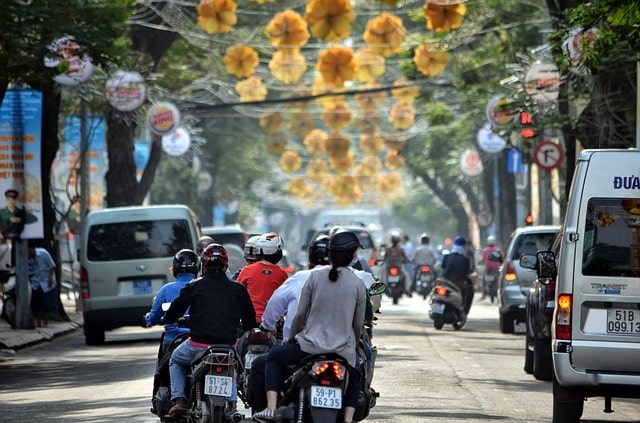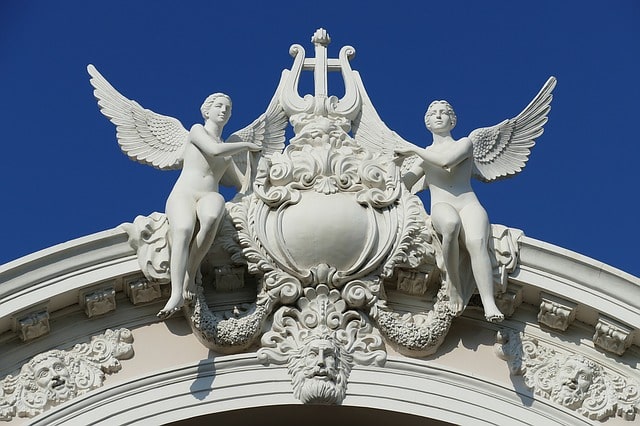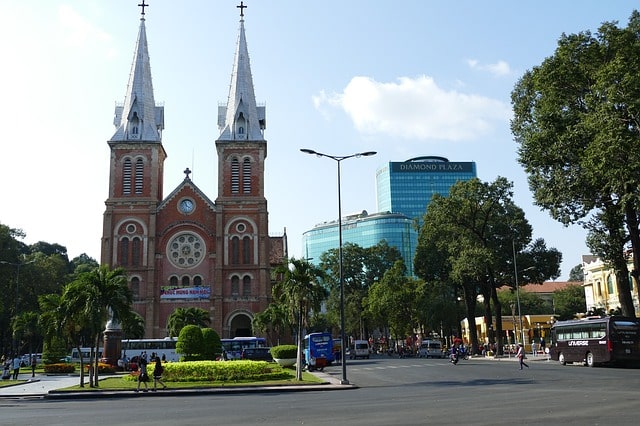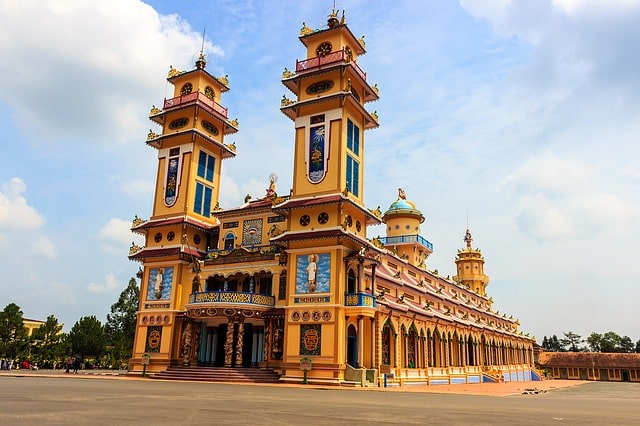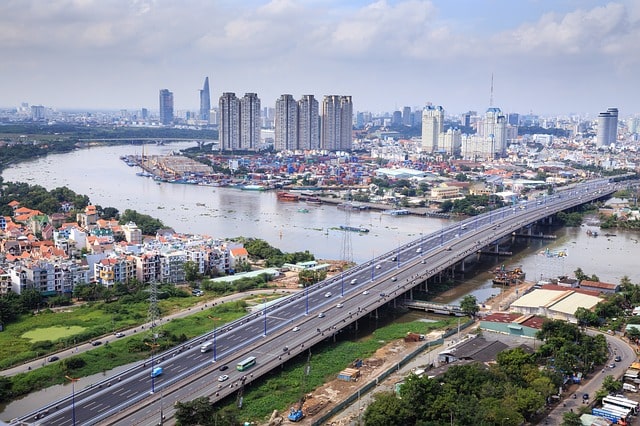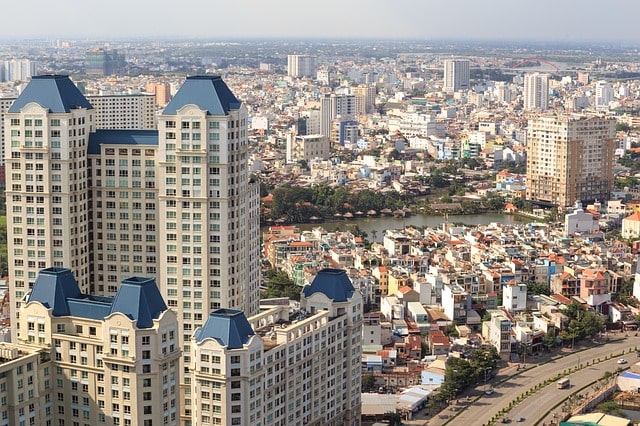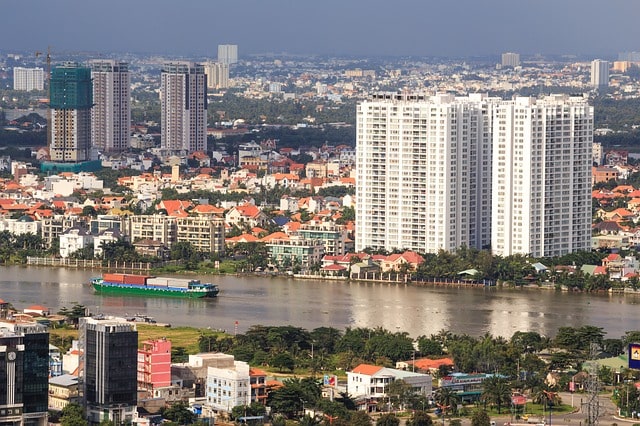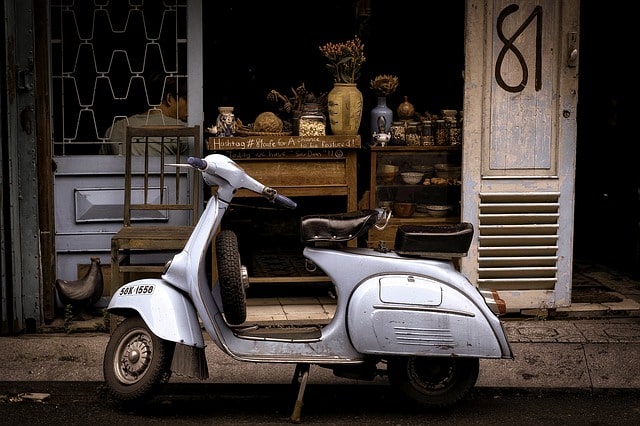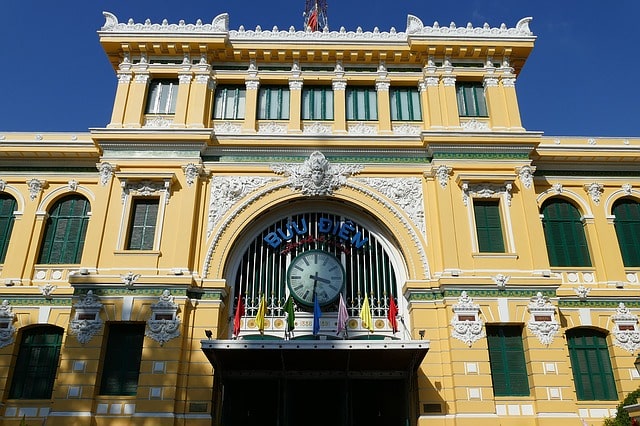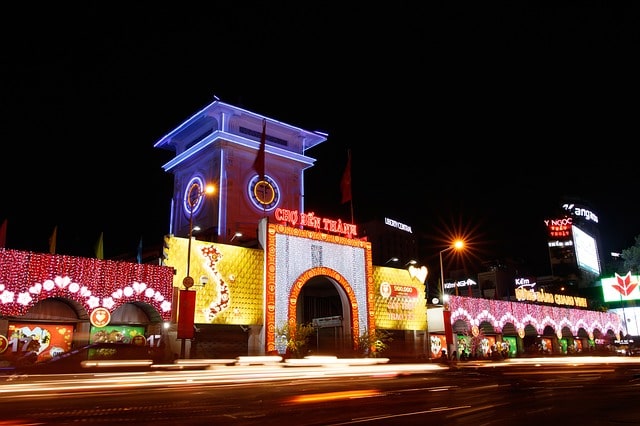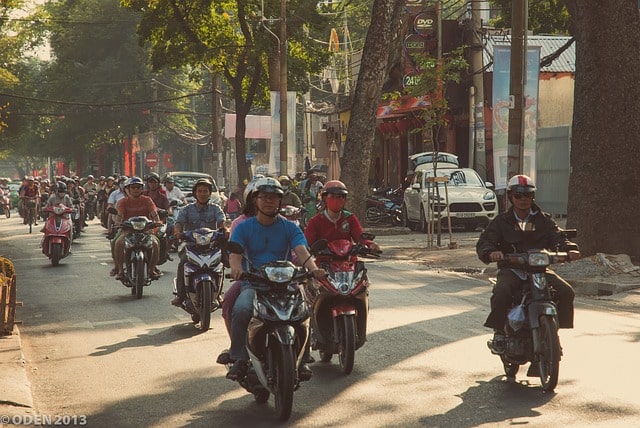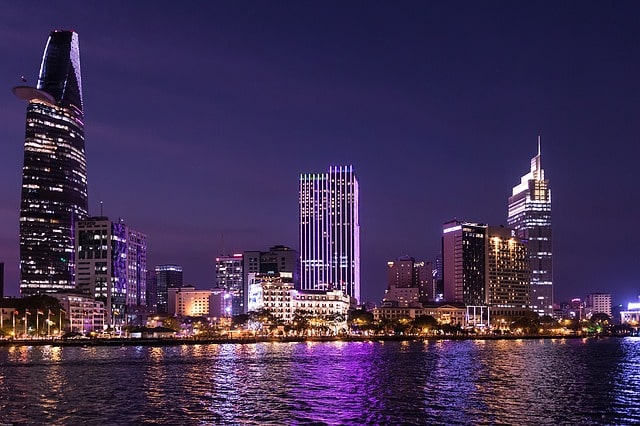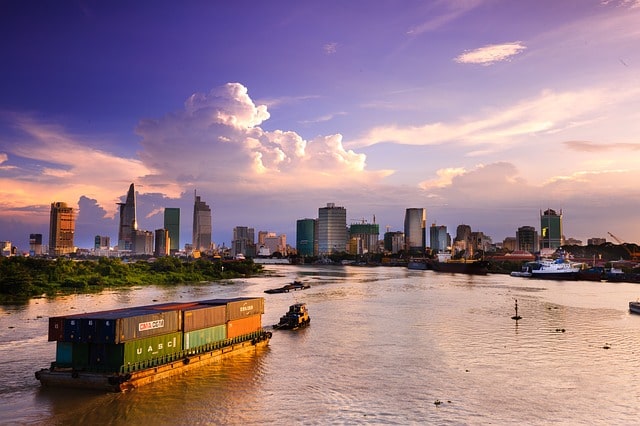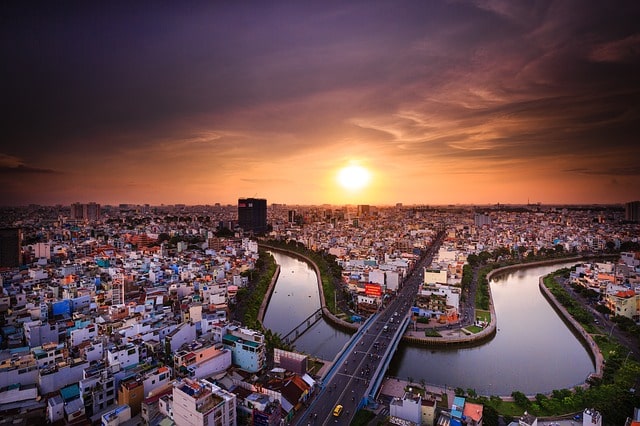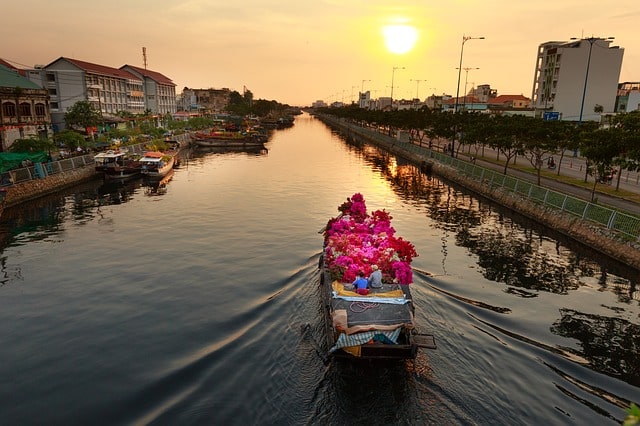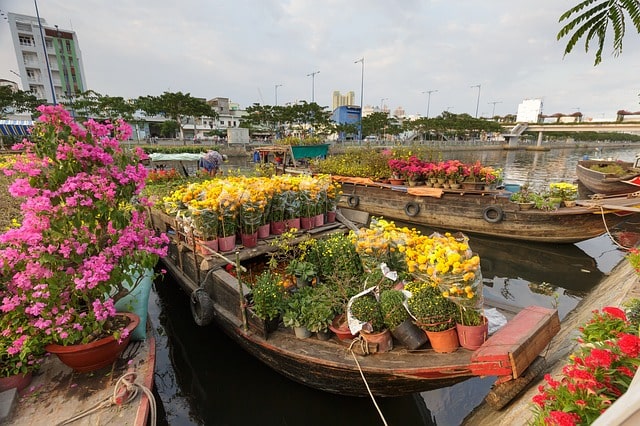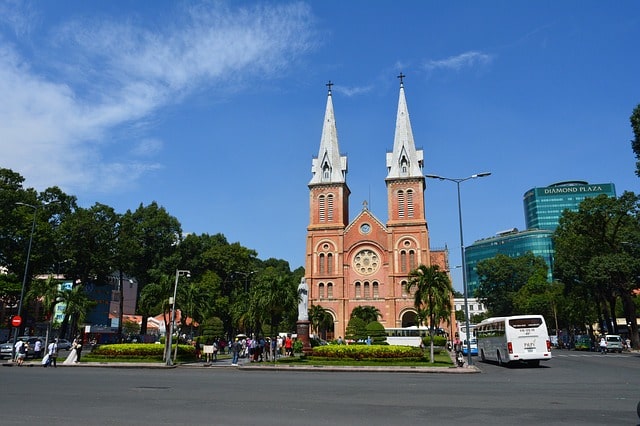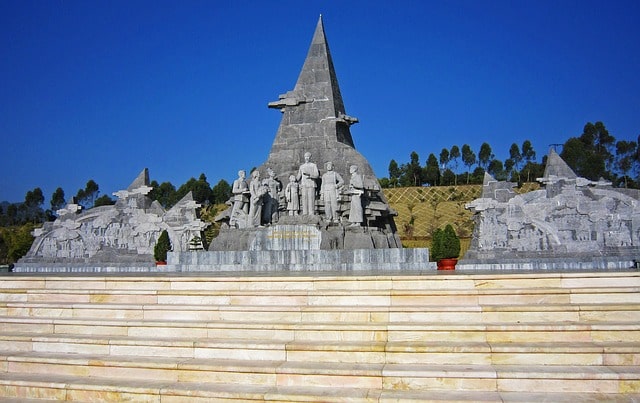Formerly called Saigon, Ho Chi Minh is one of the most important destinations in every trip through Vietnam. Former capital of the country, owes its current name to the famous leader and myth of the Vietnamese revolution Ho Chi Minh, key figure in the modern history of the country. Reflection of the historical colonial past of Vietnam, of the transformation to a socialist state and of the modernist future of the country, Ho Chi Minh is a destination that you should not miss in your trip.
Ho Chi Minh City
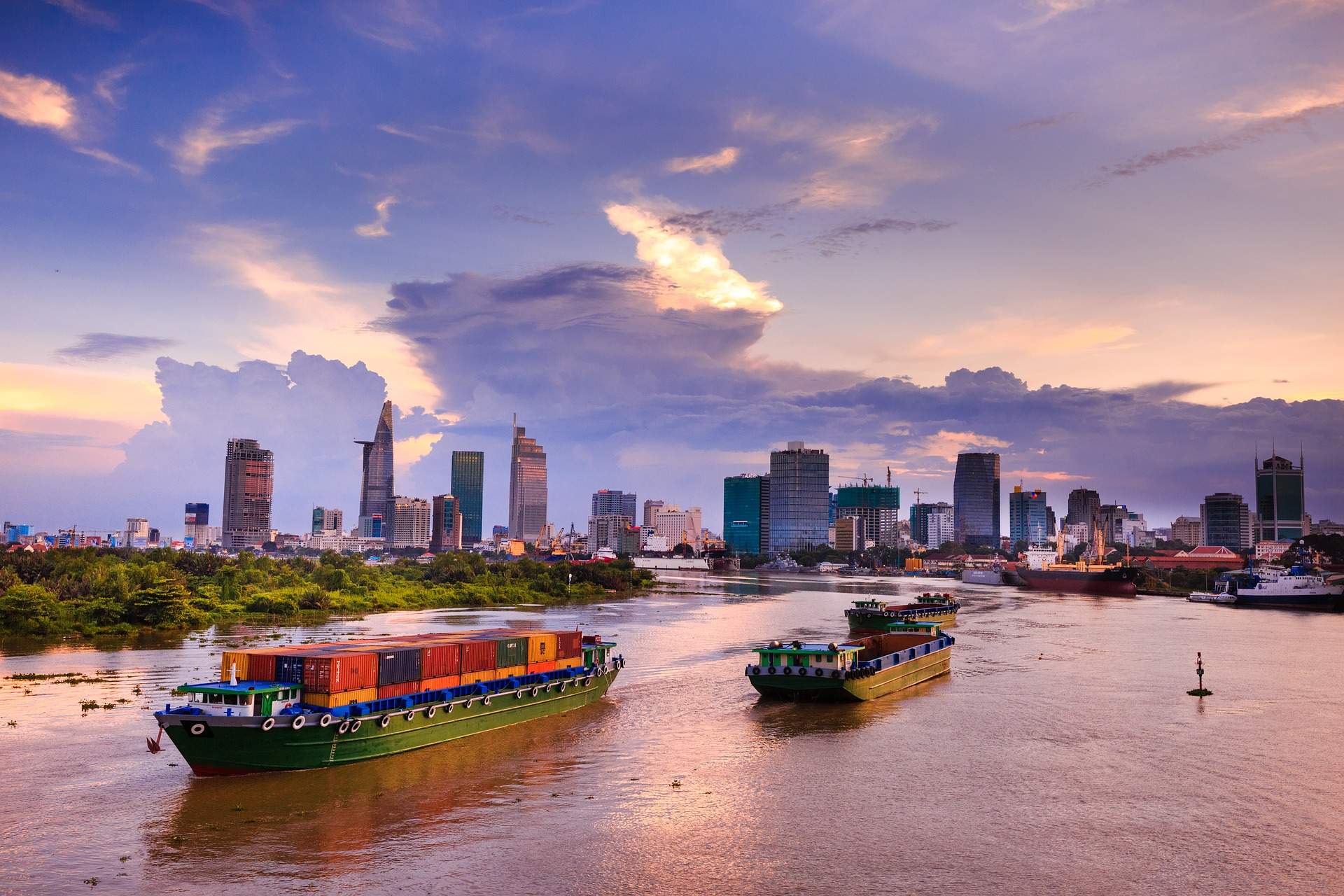
Ho Chi Minh City in Ho Chi Minh Municipality (ベトナム)
Ho Chi Minh City
Ho Chi Minh City guide
What to do in Ho Chi Minh City
Notre Dame Cathedral
The Cathedral of Notre Dam is one of the most important cathedrals in all of Southeast Asia, Built during the time of French rule, Notre Dame Cathedral stands out for its beauty and fine finishes being its most characteristic parts the 2 immense or high bell towers and the spectacular Statue of the Virgin Mary that is in the area of the entrance.
Opera house
Built in the late nineteenth century, the Palace or Opera House is another example we can find in Ho Chi Minh from the French colonial past and the importance that Saigon had in his time.
Central Post Office
Along with the aforementioned attractions, the Central Post Office allows us to get an idea of the French influence on the history of the country. The building is also famous for having been built by the great French architect Gustave Eiffel, builder of the famous Eiffel Tower in Paris.
The Pink Church of Tan Dinh
Together with the Notre Dame Cathedral, the Pink Church of Tan Dinh is another example of the Catholic past of the city and of the mixture of religions that exists in Vietnam. Classic style takes its name from the pinkish color of your entire exterior.
Giac Lam pagoda
One of the most important points within the Buddhist culture in Ho Chi Minh is the Giac lam Pagoda. Built in the mid-18th century, it is one of the oldest religious buildings in the city. The pagoda stands out for its Buddha images, especially that of its Great White Buddha sitting and its garden areas.
Jade Emperor's Pagoda
Built in the 19th century, the Pagoda of the Jade Emperor is another of the most important religious sites in the city. Its construction owes to the important Chinese community that has lived in this area of the country for centuries and is an example of the religious miscegenation that the city has. In the enclosure they emphasize especially their interiors where the different conceptions of the Taoísta religion are recreated.
War Museum
Ho Chi Minh houses the most important War Museum in all of Vietnam. In the museum you can appreciate the painful and long War of Independence that Vietnam fought against the French and North American colonialist states.
Palace of Reunification
Renowned as such to commemorate the reunification of the ancient North Vietnam and South Vietnam after the cruel civil war, the Reunification Palace is one of the country's prides and most recent anti-colonial history. Although its construction dates back to the 19th century, its current name is due to the reunification yearning that the Vietnamese always had after their colonial past.
Cu Chi tunnels
The Vietnam War can not be understood without knowing the role and sacrifice that the Vietnamese people who supported the communist north. Thanks to its audacity and to this network of tunnels, the Vietcong guerrilla (communist bases that had in the south of Vietnam) managed to take the war from the front to the same city of Saigon. The current attraction is to know the conditions of life and war that that guerrilla lived in the famous network of Tunnels of Cu Chi.
Ben Thanh Market
The Ben Thanh Market is the most important market in the city of Ho Chi Minh City. From morning to night at the Ben Thanh Market we can find all kinds of souvenirs and enjoy the incredible Vietnamese cuisine in its many small street restaurants.
Visit Pham Ngu Lao
Pham Ngu Lao is the backpacker neighborhood of Ho Chi Minh. Meeting point of the most alternative travelers who are touring Vietnam, Pham Ngu Lao is perfect to stay or to enjoy a night with its backpacker atmosphere.
Food in Ho Chi Minh City
As in the south grows a greater variety of tropical fruits and vegetables, and a wider variety of spices is used in their kitchen, which is why cooking in Ho Chi Minh is so aromatic and almost everything is cooked in coconut milk and they use more sugar in their recipes, even in the most salty dishes.
A typical dish of the city is the Thit Kho nuoc dua (Pork cooked simmered in coconut milk).
Sugarcane is abundant, and in addition to using it in the kitchen, they chew it as a sandwich or snack and drink their juice, just as we do here in our tropical countries
As for the kitchen cooking times are shorter, and heavy stews and fried dishes are less frequent than in the north.
Among the typical dishes of the city we also find the Bánh xeo of Indian cuisine influence and is like a dhosa, or large crepe stuffed with sweets like mango or coconut sweets and which the Vietnamese prepare with rice flour and milk of coconut, it is found in the evenings at street food stalls, also these crepes can be filled with meat and seafood, as well as vegetables.
Climate in Ho Chi Minh City
In Ho Chi Minh City, the wet season is overcast, the dry season is partly cloudy, and it is hot and oppressive year round. Over the course of the year, the temperature typically varies from 71°F to 94°F and is rarely below 67°F or above 97°F.
The best time of year to visit Ho Chi Minh City for hot-weather activities is from early December to late March.
SECC 3 APARTMENT
Destination: Ho Chi Minh City
SECC 3 APARTMENT features air-conditioned rooms with cable flat-screen TV in the District 7 district of Ho Chi Minh City. This 3-star hotel offers an ATM and a concierge service. The accommodation...
Auhome- Minimalist Apartment
Destination: Ho Chi Minh City
この施設情報はただいま翻訳準備中です。ご迷惑をおかけいたしますが更新までしばらくお待ちください。 Located 400 metres from Tan Dinh Market in Ho Chi...
ACE Hotel - Bến Thành
Destination: Ho Chi Minh City
Placed in the heart of Ho Chi Minh City and just a 5-minute walk to the popular Ben Thanh Market, Ace Hotel offers well-appointed rooms with free Wi-Fi access. It also houses a business...
Seven Apartment
Destination: Ho Chi Minh City
Set less than 1 km from Nha Rong Wharf, Seven Apartment features free WiFi and units equipped with a kitchenette, patio, seating area and flat-screen TV. A microwave and fridge are also featured,...
Aladdin Hotel
Destination: Ho Chi Minh City
Located in Ho Chi Minh City, 2.3 km from Tan Dinh Market, Aladdin Hotel features a shared lounge and views of the city. With a garden, the 3-star hotel has air-conditioned rooms with free WiFi,...
Ciao SaiGon Airport Hotel & Apartment
Destination: Ho Chi Minh City
Featuring a fitness centre and a terrace, Ciao SaiGon Airport Hotel & Apartment is located in Ho Chi Minh City, 4.3 km from Tan Dinh Market and 4.3 km from Giac Lam Pagoda. Among the facilities of...
Norfolk Hotel Saigon
Destination: Ho Chi Minh City
Established as the first Australian-owned hotel in District 1, Norfolk Hotel Saigon offers accommodation in the heart of Ho Chi Minh City. A 3-minute walk can take you to the City Hall and Ho Chi...
Lief Mojo Sai Gon
Destination: Ho Chi Minh City
Situated in Ho Chi Minh City, Lief Mojo Saigon offers accommodation with private balconies. Among the facilities of this property are a restaurant, a 24-hour front desk and room service, along...
Cupid Hotel
Destination: Ho Chi Minh City
Attractively situated in the District 1 district of Ho Chi Minh City, Cupid Hotel is located 1.4 km from Tao Dan Park, 1.6 km from Fine Arts Museum and 1.6 km from Ho Chi Minh City Museum. The...
Golda Hotel
Destination: Ho Chi Minh City
この施設情報はただいま翻訳準備中です。ご迷惑をおかけいたしますが更新までしばらくお待ちください。 Golda Hotel is located in Ho Chi Minh City, 2.9 km...
Tuyết Sự Hotel
Destination: Ho Chi Minh City
この施設情報はただいま翻訳準備中です。ご迷惑をおかけいたしますが更新までしばらくお待ちください。 Situated in Ho Chi Minh City and with Saigon Notre...
Triple E Hotel Fine Art Museum
Destination: Ho Chi Minh City
Triple E features air-conditioned rooms with cable flat-screen TV in the District 1 district of Ho Chi Minh City. Among the facilities of this property are a restaurant, a 24-hour front desk and...
Honey House Hotel
Destination: Ho Chi Minh City
この施設情報はただいま翻訳準備中です。ご迷惑をおかけいたしますが更新までしばらくお待ちください。 Offering free WiFi, RedDoorz near SaiGon Square...
Cityhouse - Atelier Apartment & Hotel
Destination: Ho Chi Minh City
Conveniently set in the District 2 district of Ho Chi Minh City, ATELIER THAO DIEN is located 2.9 km from Landmark 81, 6 km from Museum of Vietnamese History and 6 km from Union Square. Among the...
★★★
The White Hotel 8A Thai Van Lung
Destination: Ho Chi Minh City
この施設情報はただいま翻訳準備中です。ご迷惑をおかけいたしますが更新までしばらくお待ちください。 Situated at Ho Chi Minh’s city centre,The White...
PIANO HOTEL
Destination: Ho Chi Minh City
Attractively set in the District 1 district of Ho Chi Minh City, PIANO HOTEL is located a 4-minute walk from Fine Arts Museum, 0.6 miles from Takashimaya Vietnam and a 13-minute walk from Ben...
Emerald Central
Destination: Ho Chi Minh City
Located within 400 m of Tan Dinh Market in Ho Chi Minh City, Emerald Central offers a fitness centre and a garden. With a terrace, the 3-star hotel has air-conditioned rooms with free WiFi. Sai...
Galaxy Hotel
Destination: Ho Chi Minh City
Set in Ho Chi Minh City, 8 km from Tan Dinh Market, Galaxy Hotel features air-conditioned rooms with free WiFi and concierge services. All rooms boast a kitchenette, a flat-screen TV with cable...
Henry House 3
Destination: Ho Chi Minh City
Offering a terrace and free WiFi, Henry House 3 offers accommodation conveniently located in Ho Chi Minh City, within a short distance of Fine Arts Museum, Takashimaya Vietnam and Ben Thanh...
Maison Royale
Destination: Ho Chi Minh City
この施設情報はただいま翻訳準備中です。ご迷惑をおかけいたしますが更新までしばらくお待ちください。 Located in Ho Chi Minh City and with Tan Dinh...
Hai Nam Hotel
Destination: Ho Chi Minh City
Set in Ho Chi Minh City, 300 m from Ben Thanh Market, Hai Nam Hotel offers air-conditioned rooms and a terrace. With free WiFi, this 1-star hotel offers a 24-hour front desk and room service. The...
The Chill Suites - City Center
Destination: Ho Chi Minh City
Located in District 1 in Ho Chi Minh, The Chill Suites - City Center offers simple modern hotel with air-conditioning. The hotel is 800 m from the Ben Thanh Market and the Reunification...
Hotel L'Odéon Phu My Hung
Destination: Ho Chi Minh City
Located in District 7, Hotel L' Odéon Phu My Hung offers modern and elegant accommodations with free WiFi access throughout the property. Operating a 24-hour front desk, it provides free parking...
Sai Gon River Hotel
Destination: Ho Chi Minh City
Sai Gon River Hotel features air-conditioned rooms with satellite flat-screen TV in the District 2 district of Ho Chi Minh City. This 2-star hotel offers a 24-hour front desk, room service and...
Jomo
Destination: Ho Chi Minh City
Located in Ho Chi Minh City, within a 6-minute walk of Tan Dinh Market and 1.3 miles of Diamond Plaza, Jomo provides accommodations with a garden as well as free private parking for guests who...
Eden Garden Hotel
Destination: Ho Chi Minh City
Situated in the backpacker’s area, Eden Garden Hotel is about 1 km from Ben Thanh Market and Reunification Palace. It houses a spa and features a daily buffet breakfast and complimentary Wi-Fi...
Minh Khang Hotel
Destination: Ho Chi Minh City
Minh Khang Hotel is located in central Ho Chi Minh, a 30-minute drive from Tan Son Nhat International Airport. It offers free Wi-Fi and parking. A tour desk, restaurant and car rentals are...
Chaien’s House and Service Apartment
Destination: Ho Chi Minh City
Situated 2.1 km from Landmark 81 and 2.9 km from Union Square, Chaien’s hotel and service apartment in Ho Chi Minh City features air-conditioned accommodation with views of the city and free...
Le Parc Saigon Hotel
Destination: Ho Chi Minh City
Located in Ho Chi Minh City, Lestar Hotel Saigon 1 features free WiFi. The property is set 1.2 km from Fine Arts Museum. Attractions in the area include Takashimaya Vietnam, 1.5 km away, or...
Bon Ami Hotel - Thiên Xuân Hotel
Destination: Ho Chi Minh City
Thien Xuan...
Royal Hotel Saigon
Destination: Ho Chi Minh City
Centrally located in Ho Chi Minh City, Royal Hotel Saigon offers comfortable rooms with free internet access and easy access to shopping, dining and nightlife options. Rooms at Royal Saigon Hotel...
City View Hotel & Spa
Destination: Ho Chi Minh City
この施設情報はただいま翻訳準備中です。ご迷惑をおかけいたしますが更新までしばらくお待ちください。 About 10 minutes' walk from Ben Thanh Market, City...
Quy Hung Hotel Central
Destination: Ho Chi Minh City
ホーチミン市の1区にあるQuy Hung...
Saki Aparthotel
Destination: Ho Chi Minh City
Located in Ho Chi Minh City in the Ho Chi Minh Municipality region, with Saigon Exhibition and Convention Center nearby, Saki Aparthotel has accommodations with free WiFi and free private parking....
★★★
Lá Hotel Q10
Destination: Ho Chi Minh City
You're eligible for a Genius discount at Lá Hotel Q10! To save at this property, all you have to do is sign in. Located in Ho Chi Minh City, 1.7 miles from Giac Lam Pagoda, Lá Hotel Q10 features...
Le Ai Hotel
Destination: Ho Chi Minh City
この施設情報はただいま翻訳準備中です。ご迷惑をおかけいたしますが更新までしばらくお待ちください。 Situated within 2 km of An Dong Plaza and 3.7 km...
LANDMARK 81, LANDMARK
Destination: Ho Chi Minh City
Boasting a garden, fitness centre and views of pool, LANDMARK 81, LANDMARK is set in Ho Chi Minh City, 800 m from Landmark 81. Among the facilities of this property are a restaurant, a 24-hour...
★★
Calmette Hotel Ben Thanh
Destination: Ho Chi Minh City
Calmette Hotel Ben ThanhではGenius割引をご利用いただけます。お得に予約するには、ログインするだけ! Calmette Hotel Ben...
HONGVINA 97 HOTEL
Destination: Ho Chi Minh City
Situated in Ho Chi Minh City, 9 km from Landmark 81, HONGVINA 97 HOTEL features views of the city. Among the facilities at this property are a 24-hour front desk and room service, along with free...
Sao Nam Hotel - Bui Vien Walking Street
Destination: Ho Chi Minh City
Sao Nam Hotel (Southern Star...
Khách sạn Đại Lạc 1*
Destination: Ho Chi Minh City
Boasting a bar, Khách sạn Đại Lạc 1* is set in Ho Chi Minh City in the Ho Chi Minh Municipality region, 5 km from Dam Sen Cultural Park and 6 km from Giac Lam Pagoda. This 1-star hotel...
Honeymoon Hotel
Destination: Ho Chi Minh City
この施設情報はただいま翻訳準備中です。ご迷惑をおかけいたしますが更新までしばらくお待ちください。 Boasting a shared lounge, Honeymoon Hotel is...
Nhat Minh Anh Hotel
Destination: Ho Chi Minh City
ホーチミン・シティにあるNhat Minh Anh...
★
Zelda House
Destination: Ho Chi Minh City
この施設情報はただいま翻訳準備中です。ご迷惑をおかけいたしますが更新までしばらくお待ちください。 This stylish boutique property is situated a...
H79 HOTEL
Destination: Ho Chi Minh City
Attractively situated in the Tan Binh district of Ho Chi Minh City, H79 HOTEL is situated 3.6 km from Giac Lam Pagoda, 4.3 km from Tan Dinh Market and 5 km from Dam Sen Cultural Park. Featuring a...
DYN OPERA Hotel
Destination: Ho Chi Minh City
Situated in Ho Chi Minh City, DYN OPERA HOTEL is a 5-minute drive from the Saigon Opera House. It features a business centre, a restaurant and complimentary Wi-Fi access. The hotel is a 10-minute...
★★★★★
Fusion Original Saigon Centre
Destination: Ho Chi Minh City
You're eligible for a Genius discount at Fusion Original Saigon Centre! To save at this property, all you have to do is sign in. Fusion Original Saigon Centre has a restaurant, outdoor swimming...
Atlas Hotel & Apartments
Destination: Ho Chi Minh City
Located within a 5-minute walk to SC VivoCity and Crescent Mall, Atlas Hotel & Apartments in Ho Chi Minh City provides accommodation with a kitchen. Free WiFi is featured. Fitted with a terrace,...
Best price
Best price guaranteed.
No surprises
Availability confirmation and instant booking.
Discounts
When making your reservation you'll receive discounts and free services.
Privacy policy
Cookie policy & legal warning
To improve your experience, we and third parties use cookies to adapt to your preferences, provide secure access to the site, analyze traffic on our site, and deliver content and advertisements tailored to your interests. By continuing to navigate through our site you accept our Cookies Policy.

 English
English
 Español
Español
 Français
Français
 Italiano
Italiano
 Português
Português
 Deutsch
Deutsch
 简体中文
简体中文
 Filipino
Filipino
 Bahasa Malaysia
Bahasa Malaysia
 한국어
한국어
 Tiếng Việt
Tiếng Việt
 ภาษาไทย
ภาษาไทย
 繁體中文
繁體中文
 हिन्दी
हिन्दी
 Eesti
Eesti
 Slovenčina
Slovenčina
 Slovenščina
Slovenščina





















